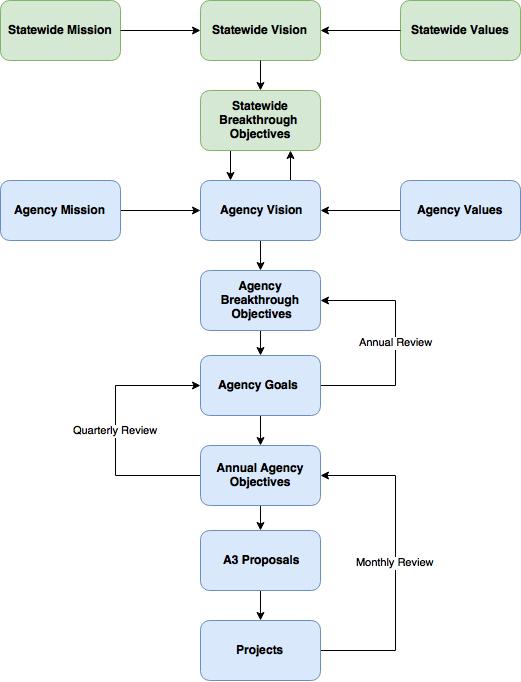A STRATEGIC PLANNING PROCESS FOR NOW AND THE FUTURE:
The State’s Strategic Planning (Plan) process [modified Hoshin Kanri] is intended to ensure Vermont achieves our 10 Population-Level Outcomes (3 V.S.A. § 2311 (b)) and gubenatorial sub-Outcomes. These Outcomes are the overarching goals for the best Vermont can achieve and the well-being of our citizenry. As an enterprise, for a 5-year period, we will collaboratively focus on Economic Growth, Affordability, Protection of Vermont’s Vulnerable and Government Modernization. Agencies will continue to focus on their areas of responsibilities, such as: education; safety; environment; children and families; communities; transportation; infrastructure; financial services and others.
We intend for this process, but not these priorities, to be the permanent, imbedded strategic planning process - used by future Administrations. Future Administrations will choose to develop Plans with their own primary areas of focus. However, the value of a consistent, imbedded planning process to effectively run state government, regardless of politics or party, cannot be over stated. The Plan timeframe is intended to be a rolling 5-year period, with annual updates and realignment, based on actual achievements as necessary.
fig.1 - Vermont's modified Hoshin Kanri process map

TOP DOWN VISION – BOTTOM UP APPROACH:
January 2017: The pre-planning process began with senior management and key staff training, and exercises in developing targeted action plans impacting the top strategic areas of focus. The Strategic Plan framework is based on Hoshin Kanri. Hoshin Kanri is a method for ensuring that the strategic outcomes drive progress and action at every level within that organization. This is intended to eliminate the waste from inconsistent direction and poor communication. The Plan is crafted to address a small number of critical issues. The Cabinet Agencies & Departments developed Strategic Goals, which inform the Strategic Statements on the Economy, Affordability, Vulnerable, and Modernization.
MEASURING OUR PROGRESS AND ACHIEVEMENT:
Breakthrough Indicators measure the achievement of our Strategic Outcomes. An Indicator is a measure which helps quantify the achievement of an Outcome. For example: If we want to measure whether we are achieving the Outcome “All Vermonters are Healthy” – we could use “Vermont’s Obesity Rate” as an Indicator, because a good deal of data tells us obesity is deleterious to heath.
The Plan Goals, when completed are expected to “move the needle” on the Breakthrough Indicators selected to inform our Strategic Outcomes. One of our Strategic Outcomes is Growing Vermont’s Economy; one of the Indicators we will use to measure whether we are achieving economic growth is “Wage Growth by County”. Growing Wages indicates that the economy is indeed growing. Measuring by county informs us if the overall growth is impacting all of Vermont equally. The initial Plan period is 5-years, with annual updates and expansion to the next year. Measuring the Indicators will tell us how we are progressing throughout the period.
TRANSPARENCY AND ACCOUNTABILITY:
The Plan must be transparent, and government must be accountable for its achievement. To facilitate transparency, the Plan with benchmarks, is published and publicly available on this site. Shortly after publication, action plans detailing exactly how each goal will be achieved will be developed by Cabinet Agency and Department staff and will include measurable deliverables and timelines. Annually, a new year will be added, along with any updates necessary for existing goals. Updated Indicator results will be displayed on the Dashboard section with supporting narratives and downloadable data. Publishing Indicators, narratives and data will hold government accountable to explain why a measure met the target or not.
